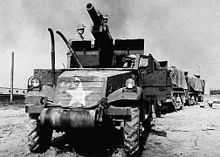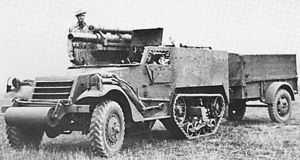T19 Howitzer Motor Carriage
| T19 Howitzer Motor Carriage | |
|---|---|
|
A T19 Howitzer Motor Carriage. | |
| Type | Self-propelled gun |
| Place of origin | United States |
| Service history | |
| In service | 1942–45 |
| Used by | United States |
| Wars | World War II |
| Production history | |
| Designer | Aberdeen Proving Ground |
| Designed | 1941 |
| Manufacturer | Diamond T |
| Produced | January – April 1942 |
| Number built | 324 |
| Specifications | |
| Weight | 9.54 t (21,000 lb) |
| Length | 20 ft 2 in (6.15 m) |
| Width | 6 ft 5 in (1.96 m) |
| Height | 7 ft 8 in (2.34 m) |
| Crew | 9 |
|
| |
| Armor |
Howitzer shield: 0.25 in (6.4 mm) Windshield: 0.50 in (13 mm) Sides and rear: 0.25 in (6.4 mm) |
Main armament | M2A1 105 mm Howitzer (8 rounds) |
Secondary armament | .50 cal (12.7 mm) M2 Browning machine gun |
| Engine |
White 160AX, 386 in3 (6,330 cc), 6-cylinder, gasoline, compression ratio 6.3:1 147 hp |
| Power/weight | 14.7 hp/tonne |
| Suspension |
front: semi-elliptical longitudinal leaf spring rear: vertical volute springs |
| Fuel capacity | 60 US gal (230 l) |
Operational range | 200 mi (320 km) |
| Speed | 45 mph (72 km/h) |
The T19 Howitzer Motor Carriage (HMC), was a World War II United States Army self-propelled gun mounted on a half-track chassis. It was equipped with a 105 mm (4.1 in) howitzer and an air-cooled .50 in (13 mm) caliber M2 machine gun. It was produced by Diamond T between January 1942 and April 1942.
It principally served in the North African Campaign, although some served in the Sicilian Campaign, the Italian Campaign, and even as late as the invasion of southern France in 1944.
Specifications
The T19 Howitzer Gun Motor Carriage was similar to the M3 Half-track. The T19 was 20 ft 2 in long, 6 ft 5 in wide, 7 ft 8 in high, with a weight of 9.54 short tons. The suspension consisted of a semi-elliptical longitudinal leaf spring for the wheels and vertical volute springs for the tracks. Powered by a White 160AX, 147 hp, 386 in3, 6-cylinder petrol engine with a compression ratio of 6.3:1, it was capable of a maximum road speed of 45 mph. The power to weight ratio was 14.7 hp/tonne. The vehicle was operated by a crew of six. Maximum armor was only 0.5 inch (12.7 mm) at the windshield. The armament consisted of one 105 mm M2A1 howitzer with a single .50 caliber M2 Browning machine gun for local defence.[1][2]
Development

In the autumn of 1941, when the Armored Force expanded, an urgent need for self-propelled artillery arose. Although a full-track chassis was preferred, the situation required the use of whatever vehicles were immediately available. The M3 half track was selected to carry a 105 mm M2A1 howitzer. Although this design had originally been suggested in September 1941, it had not been taken up. However, the urgency of the requirement resulted in the approval by Adjutant General and the construction of a pilot was authorized by OCM 17391, dated 31 October 1941; the new vehicle designated as 105 mm Howitzer Motor Carriage T19.[3][4][5]
As with other American self-propelled guns of early World War II, the pilot was assembled and tested at Aberdeen Proving Ground. The M2 recoil mechanism and other parts of the M2 howitzer carriage were used in the vehicle mounting. After several tests, the gun carriage proved fragile on bumpy terrain. The problem was corrected by reinforcing the frame, and redesigning the howitzer mount. Demountable headlights were recommended because of the muzzle blast, although they were not available for early production models. Early models had no shield for the howitzer either, but a foldable shield was added during testing. The gun faced forward, like many other halftrack models. The total traverse was 40 degrees and the elevation was from −5 to +35 degrees. The armored windshield cover was remounted so it could fold onto the hood. After further testing, it was accepted for production.[6][7]
After the design was accepted, a pilot was shipped to Diamond T as a guide for production. The first production vehicle was delivered to the US Army in January 1942. A total of 324 T19s had been made by the time production ended in April 1942.[7][8]
Service history
The T19 HMC was designed as a stopgap measure until better self-propelled artillery pieces were made; it served in the Tunisia Campaign in North Africa in 1942–43, but the M7 Priest, a 105 mm howitzer on a fully tracked chassis, soon replaced it in armored divisions.[9] A few served in Sicily and Italy.[4] It was finally declared obsolete in July 1945. That month, the contractor Brown & McLaughlin converted 90 T19s into M3A1 Halftracks.[7]
See also
References
Citations
- ↑ Hunnicutt 2010, p. 220.
- ↑ Berndt 1993, p. 152.
- ↑ Hunnicutt 2010, p. 112.
- ↑ 4.0 4.1 Zaloga 1994, p. 37.
- ↑ Berndt 1994, pp. 26–30.
- ↑ Zaloga 1994, pp. 37–38.
- ↑ 7.0 7.1 7.2 Hunnicutt 2010, p. 113.
- ↑ Ness 2002, p. 196.
- ↑ Chamberlain & Ellis 1969, p. 191.
Bibliography
- Berndt, Thomas (1993). Standard Catalog of U.S. Military Vehicles. Iola, WI: Krause Publications. ISBN 0-87341-223-0.
- Berndt, Thomas (1994). American Tanks of World War II. Minnesota, MN: MBI Publishing Company. ISBN 0-87938-930-3.
- Chamberlain, Peter; Ellis, Chris (1969). British and American Tanks of World War II. New York, NY: Arco Publishing Inc. ISBN 0-668-01867-4.
- Hunnicutt, R.P. (2010). Half-Track: A History of American Semi-Tracked Vehicles. Navato, CA: Presidio Press. ISBN 0-89141-742-7.
- Ness, Leland (2002). Jane's World War II Tanks and Armored Fighting Vehicles. London, UK: HarperCollins. ISBN 0-00-711228-9.
- Zaloga, Steven J. (1994). M3 Infantry Half-Track 1940–1973. Oxford, UK: Osprey Publishing. ISBN 1-85532-467-9.
External links
| Wikimedia Commons has media related to 105mm Howitzer Motor Carriage T19. |
